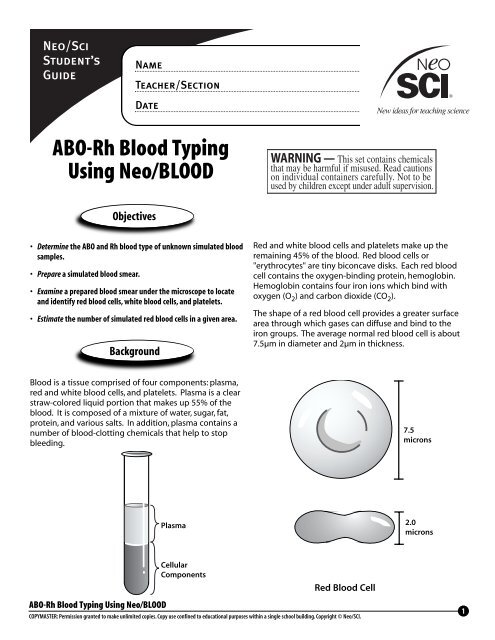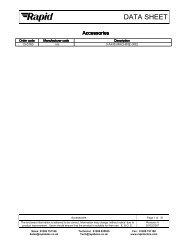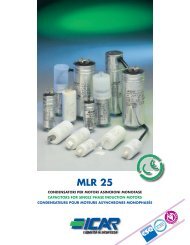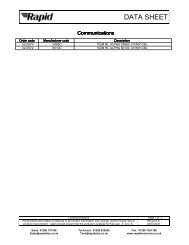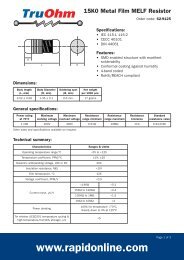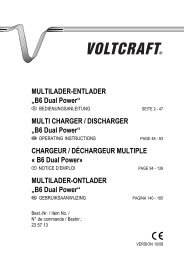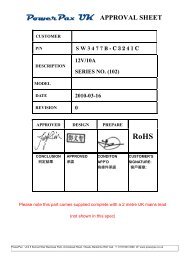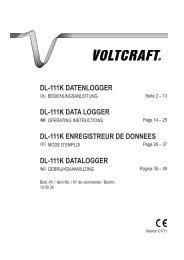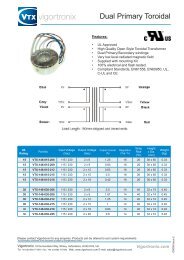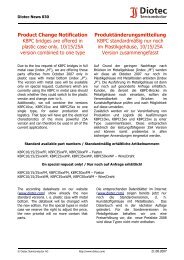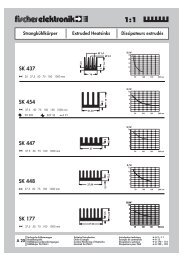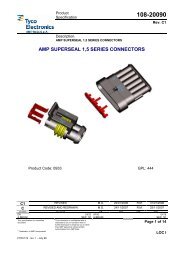ABO-Rh Blood Typing Using Neo/BLOOD Objectives Background
ABO-Rh Blood Typing Using Neo/BLOOD Objectives Background
ABO-Rh Blood Typing Using Neo/BLOOD Objectives Background
Create successful ePaper yourself
Turn your PDF publications into a flip-book with our unique Google optimized e-Paper software.
<strong>Neo</strong>/Sci<br />
Student’s<br />
Guide<br />
Name<br />
Teacher/Section<br />
Date<br />
<strong>ABO</strong>-<strong>Rh</strong> <strong>Blood</strong> <strong>Typing</strong><br />
<strong>Using</strong> <strong>Neo</strong>/<strong>BLOOD</strong><br />
<strong>Objectives</strong><br />
• Determine the <strong>ABO</strong> and <strong>Rh</strong> blood type of unknown simulated blood<br />
samples.<br />
• Prepare a simulated blood smear.<br />
• Examine a prepared blood smear under the microscope to locate<br />
and identify red blood cells, white blood cells, and platelets.<br />
• Estimate the number of simulated red blood cells in a given area.<br />
<strong>Background</strong><br />
Red and white blood cells and platelets make up the<br />
remaining 45% of the blood. Red blood cells or<br />
"erythrocytes" are tiny biconcave disks. Each red blood<br />
cell contains the oxygen-binding protein, hemoglobin.<br />
Hemoglobin contains four iron ions which bind with<br />
oxygen (O 2 ) and carbon dioxide (CO 2 ).<br />
The shape of a red blood cell provides a greater surface<br />
area through which gases can diffuse and bind to the<br />
iron groups. The average normal red blood cell is about<br />
7.5µm in diameter and 2µm in thickness.<br />
<strong>Blood</strong> is a tissue comprised of four components: plasma,<br />
red and white blood cells, and platelets. Plasma is a clear<br />
straw-colored liquid portion that makes up 55% of the<br />
blood. It is composed of a mixture of water, sugar, fat,<br />
protein, and various salts. In addition, plasma contains a<br />
number of blood-clotting chemicals that help to stop<br />
bleeding.<br />
7.5<br />
microns<br />
Plasma<br />
2.0<br />
microns<br />
Cellular<br />
Components<br />
Red <strong>Blood</strong> Cell<br />
<strong>ABO</strong>-<strong>Rh</strong> <strong>Blood</strong> <strong>Typing</strong> <strong>Using</strong> <strong>Neo</strong>/<strong>BLOOD</strong><br />
COPYMASTER: Permission granted to make unlimited copies. Copy use confined to educational purposes within a single school building. Copyright © <strong>Neo</strong>/SCI.<br />
1
<strong>Neo</strong>/Sci<br />
Student’s<br />
Guide<br />
Name<br />
Teacher/Section<br />
Date<br />
Safety & Disposal<br />
<strong>Blood</strong> functions principally as a vehicle which transports<br />
gases, metabolic waste products and hormones<br />
throughout the body. As blood passes through the<br />
lungs, oxygen molecules attach to the hemoglobin. As<br />
blood passes through the body’s tissues in capillary<br />
beds, the hemoglobin releases the oxygen. Carbon<br />
dioxide and other waste gases are, in turn, transported<br />
by the hemoglobin back to the lungs. Thereafter, the<br />
process is repeated.<br />
The simulated <strong>Neo</strong>/<strong>BLOOD</strong> and sera samples provided in<br />
this kit contain no biological components and are<br />
therefore safe from any potential biological hazards.<br />
However, you should always wear safety goggles, gloves<br />
and a lab apron to protect the eyes and clothing when<br />
working with any chemicals. The dye in the simulated<br />
<strong>Neo</strong>/<strong>BLOOD</strong> solution will stain your skin and clothing.<br />
Be sure that you wash your hands before leaving the<br />
laboratory.<br />
Any simulated <strong>Neo</strong>/<strong>BLOOD</strong> waste from this lab may be<br />
disposed of by pouring it down the drain with copious<br />
amounts of water.<br />
<strong>ABO</strong>-<strong>Rh</strong> <strong>Blood</strong> <strong>Typing</strong> <strong>Using</strong> <strong>Neo</strong>/<strong>BLOOD</strong><br />
COPYMASTER: Permission granted to make unlimited copies. Copy use confined to educational purposes within a single school building. Copyright © <strong>Neo</strong>/SCI.<br />
2
<strong>Neo</strong>/Sci<br />
Student’s<br />
Guide<br />
Name<br />
Teacher/Section<br />
Date<br />
Activity 1<br />
Determining the <strong>ABO</strong>-<strong>Rh</strong> <strong>Blood</strong> Type<br />
of Simulated <strong>Blood</strong> Samples<br />
Surface proteins on red blood cells determine an individual's<br />
blood type. These surface proteins are called<br />
"antigens."<br />
The system used to classify human blood is called the<br />
"<strong>ABO</strong> system." Dr. Karl Landsteiner, an Austrian physician,<br />
received the Nobel Prize in physiology for this discovery<br />
in 1930.<br />
With the <strong>ABO</strong> system, the kinds of antigens present on<br />
red blood cells determines the blood type. An individual<br />
with A antigens has blood type A, one with B antigens<br />
has blood type B, one with both A and B antigens has<br />
blood type AB, and one with no antigens on the surface<br />
of his/her red blood cells has type O.<br />
<strong>Blood</strong> plasma has circulating proteins called "antibodies".<br />
For example, individuals with A surface antigen<br />
have anti-B antibodies; those with B surface antigen<br />
have anti-A antibodies. Those with both A and B surface<br />
antigens have no antibodies. Individuals with no surface<br />
antigens have both anti-A and anti-B antibodies.<br />
<strong>Blood</strong> typing is performed using "antiserum" - blood that<br />
contains specific antibodies. "Anti-A Serum," which contains<br />
anti-A antibodies, and "Anti-B Serum," which contains<br />
anti-B antibodies, are used in <strong>ABO</strong> blood typing.<br />
Anti-A antibody<br />
A antigen<br />
Anti-B antibody<br />
B antigen<br />
<strong>Blood</strong> Type A<br />
<strong>Blood</strong> Type B<br />
B antigen<br />
A antigen<br />
Anti-A antibody<br />
Anti-B antibody<br />
<strong>Blood</strong> Type AB<br />
<strong>Blood</strong> Type O<br />
<strong>ABO</strong>-<strong>Rh</strong> <strong>Blood</strong> <strong>Typing</strong> <strong>Using</strong> <strong>Neo</strong>/<strong>BLOOD</strong><br />
COPYMASTER: Permission granted to make unlimited copies. Copy use confined to educational purposes within a single school building. Copyright © <strong>Neo</strong>/SCI.<br />
3
<strong>Neo</strong>/Sci<br />
Student’s<br />
Guide<br />
Name<br />
Teacher/Section<br />
Date<br />
To perform a blood typing test, anti-A and anti-B sera are<br />
each separately mixed with a drop of sample blood and<br />
observed for "agglutination" or clumping.<br />
Another important antigen on the surface of red blood<br />
cells is the <strong>Rh</strong> protein, named for the rhesus monkey in<br />
which it was first studied.<br />
People who have this protein are "<strong>Rh</strong>-positive," and<br />
those who lack it are "<strong>Rh</strong>-negative."<br />
<strong>Rh</strong>-negative individuals who have been transfused with<br />
<strong>Rh</strong>-positive blood can produce <strong>Rh</strong> antibodies. They may<br />
develop a transfusion reaction, during which agglutination<br />
may occur, if they are transfused again with <strong>Rh</strong>-positive<br />
blood. Usually <strong>Rh</strong> compatibility is tested when the<br />
<strong>ABO</strong> blood type is determined.<br />
Data Table 2<br />
Agglutination Reactions in the <strong>ABO</strong> System<br />
<strong>ABO</strong> Agglutination Reaction<br />
<strong>Blood</strong><br />
Anti-A Serum Anti-B Serum Type<br />
Agglutination No Agglutination A<br />
No agglutination Agglutination B<br />
Agglutination Agglutination AB<br />
No Agglutination No Agglutination O<br />
<strong>Rh</strong> Agglutination<br />
Reaction<br />
Data Table 3<br />
<strong>Rh</strong> Agglutination Reactions<br />
<strong>Rh</strong> Factor<br />
Agglutination +<br />
No agglutination —<br />
Data Table 1<br />
<strong>ABO</strong> <strong>Blood</strong> Types Summary<br />
Data Table 4<br />
Frequency of <strong>ABO</strong> <strong>Blood</strong> Types and <strong>Rh</strong> Factor in the U.S.<br />
<strong>Blood</strong><br />
Type<br />
Antigen<br />
on Red<br />
<strong>Blood</strong><br />
Cells<br />
Antibodies<br />
in Plasma<br />
Can<br />
Receive<br />
<strong>Blood</strong><br />
From …<br />
Can<br />
Donate<br />
<strong>Blood</strong><br />
To …<br />
<strong>Blood</strong> Type<br />
Frequency<br />
Percentage<br />
<strong>Blood</strong> Type<br />
& <strong>Rh</strong> Factor<br />
Frequency<br />
Percentage<br />
A A B O, A A, AB<br />
B B A O,B B,AB<br />
AB A and B None O, AB, A, B AB<br />
O None A and B O O, A, B, AB<br />
A 42<br />
B 10<br />
AB 4<br />
O 44<br />
A +<br />
A –<br />
B +<br />
B –<br />
AB +<br />
AB –<br />
O +<br />
O –<br />
34<br />
8<br />
8<br />
2<br />
3<br />
1<br />
35<br />
9<br />
<strong>ABO</strong>-<strong>Rh</strong> <strong>Blood</strong> <strong>Typing</strong> <strong>Using</strong> <strong>Neo</strong>/<strong>BLOOD</strong><br />
COPYMASTER: Permission granted to make unlimited copies. Copy use confined to educational purposes within a single school building. Copyright © <strong>Neo</strong>/SCI.<br />
4
<strong>Neo</strong>/Sci<br />
Student’s<br />
Guide<br />
Name<br />
Teacher/Section<br />
Date<br />
What you need<br />
Per Student:<br />
Anti-A Serum (simulated)<br />
Anti-B Serum (simulated)<br />
Anti-<strong>Rh</strong> Serum (simulated)<br />
1 <strong>Blood</strong> typing tray<br />
Paper towels<br />
4 Patient <strong>Blood</strong> Samples (simulated)<br />
1 set Stirring sticks (blue, green and yellow)<br />
What to do...<br />
Step 1<br />
Place 5 drops of Patient 1 Simulated <strong>Blood</strong> Sample in<br />
each well on your blood typing tray.<br />
Step 5<br />
Use a separate stirring stick to mix the simulated blood<br />
and serum in each well for about 10 seconds.<br />
A<br />
A<br />
B<br />
B<br />
<strong>Rh</strong><br />
<strong>Rh</strong><br />
Step 2<br />
Place 3 drops of Anti-A Simulated Serum in Well A.<br />
Step 3<br />
Place 3 drops of Anti-B Simulated Serum in Well B.<br />
Step 4<br />
Place 3 drops of Anti-<strong>Rh</strong> Simulated Serum in Well <strong>Rh</strong>.<br />
Step 6<br />
Carefully examine each well to determine if the simulated<br />
blood in each well has clumped or agglutinated.<br />
Record your results and observations in Data Table 5.<br />
Step 7<br />
Thoroughly rinse the tray and stirring sticks and repeat<br />
Steps 1-6 to type the remaining, simulated blood<br />
samples.<br />
<strong>ABO</strong>-<strong>Rh</strong> <strong>Blood</strong> <strong>Typing</strong> <strong>Using</strong> <strong>Neo</strong>/<strong>BLOOD</strong><br />
COPYMASTER: Permission granted to make unlimited copies. Copy use confined to educational purposes within a single school building. Copyright © <strong>Neo</strong>/SCI.<br />
5
<strong>Neo</strong>/Sci<br />
Student’s<br />
Guide<br />
Name<br />
Teacher/Section<br />
Date<br />
Understanding Your Results:<br />
Clumping indicates that the simulated blood sample<br />
contains antigens that reacted against the antibodies in<br />
the typing serum that you mixed it with.<br />
Type A<br />
If the blood in Well A is the only blood that agglutinates<br />
or clumps, then the blood sample you tested is Type A<br />
blood.<br />
Type B<br />
If the blood in Well B is the only blood that agglutinates<br />
or clumps, then the blood sample you tested is Type B<br />
blood.<br />
Type AB<br />
If the blood in both Well A and Well B agglutinates or<br />
clumps, then the blood sample you tested is type AB<br />
blood.<br />
Type O<br />
If the blood in both Well A and Well B does not agglutinate<br />
or clump, then the blood sample you tested is Type<br />
O blood.<br />
<strong>Rh</strong><br />
If the blood in Well <strong>Rh</strong> agglutinates or clumps, then the<br />
blood sample you tested is <strong>Rh</strong> Positive blood.<br />
Data Table 5<br />
Simulated<br />
<strong>Blood</strong> Sample<br />
Agglutination<br />
in Well A<br />
(+/-)<br />
Agglutination<br />
in Well B<br />
(+/-)<br />
Agglutination<br />
in Well <strong>Rh</strong><br />
(+/-)<br />
<strong>Blood</strong> Type<br />
Observations<br />
Patient 1<br />
Patient 2<br />
Patient 3<br />
Patient 4<br />
<strong>ABO</strong>-<strong>Rh</strong> <strong>Blood</strong> <strong>Typing</strong> <strong>Using</strong> <strong>Neo</strong>/<strong>BLOOD</strong><br />
COPYMASTER: Permission granted to make unlimited copies. Copy use confined to educational purposes within a single school building. Copyright © <strong>Neo</strong>/SCI.<br />
6
<strong>Neo</strong>/Sci<br />
Student’s<br />
Guide<br />
Name<br />
Teacher/Section<br />
Date<br />
Questions<br />
1. If your blood type is B, which antigens are present on<br />
your red blood cells? What if your blood type is A,<br />
type AB, or type O?<br />
4. How could you determine if a blood sample is compatible<br />
to transfuse from one individual to another in<br />
an emergency situation, if blood typing serum is not<br />
available?<br />
2. Based upon your results, which <strong>ABO</strong> blood type can<br />
Patient 1 receive safely? Patient 2? Patient 3? And<br />
Patient 4?<br />
5. How is this simulated blood typing activity, similar to<br />
actual human blood typing?<br />
3. Which patient is considered a universal donor?<br />
6. What would happen to a type O patient if he receives<br />
type A or B blood?<br />
7. What are the consequences of <strong>Rh</strong> incompatibility?<br />
<strong>ABO</strong>-<strong>Rh</strong> <strong>Blood</strong> <strong>Typing</strong> <strong>Using</strong> <strong>Neo</strong>/<strong>BLOOD</strong><br />
COPYMASTER: Permission granted to make unlimited copies. Copy use confined to educational purposes within a single school building. Copyright © <strong>Neo</strong>/SCI.<br />
7
<strong>Neo</strong>/Sci<br />
Student’s<br />
Guide<br />
Name<br />
Teacher/Section<br />
Date<br />
Activity 2<br />
Taking a Closer Look at <strong>Blood</strong><br />
Physicians and other health care professionals regularly<br />
examine blood under the microscope to identify infections,<br />
blood cell abnormalities and to count the various<br />
types of cells.<br />
The cells of the blood are of two classes: red blood cells<br />
(RBCs), or erythrocytes; white blood cells (WBCs), or<br />
leukocytes, which in turn are of many different types.<br />
Platelets, or thrombocytes, are also present as are cell<br />
fragments.<br />
Neutrophil<br />
Eosinophil<br />
tion of the red blood cells is to transport oxygen from<br />
the lungs to the tissues. A healthy 70-kg (154-lb) man<br />
has about 5 L (5.3 qt) of blood in his body, containing<br />
more than 25 trillion RBCs. The normal life span of RBCs<br />
in the circulation is only about 120 days. Worn out RBCs<br />
are removed by the spleen and liver where hemoglobin<br />
is recycled.<br />
A number of conditions can be diagnosed based upon<br />
the red blood cell count. A high RBC level, a condition<br />
called "erythrocytosis," can be caused by smoking, living<br />
at high altitudes, or by disease. Low red blood cell levels,<br />
a condition called "anemia," can be due to a loss of<br />
blood, loss of iron, a vitamin deficiency, or other disease<br />
conditions.<br />
Lymphocyte<br />
Basophil<br />
Data Table 6<br />
Normal and Abnormal Red <strong>Blood</strong> Cell Counts<br />
RED <strong>BLOOD</strong> CELLS<br />
Red <strong>Blood</strong><br />
Cells<br />
Platelets<br />
Monocyte<br />
Red <strong>Blood</strong> Cells (RBCs)<br />
The red blood cells are tiny, round, biconcave disks, without<br />
nuclei, that average about 7.5 microns (0.003 in) in<br />
diameter. Red blood cells, as well as most white cells and<br />
platelets, are made by the bone marrow. The main func-<br />
Normal (at birth)<br />
Normal (adult)<br />
Anemia (low RBC count)<br />
Erythrocytosis<br />
(high RBC count)<br />
MALE<br />
5.1 million cells<br />
per µl<br />
5.4 million cells<br />
per µl<br />
< 4.5 million cells<br />
per µl<br />
> 6.8 million cells<br />
per µl<br />
FEMALE<br />
4.5 million cells<br />
per µl<br />
4.8 million cells<br />
per µl<br />
< 4 million cells<br />
per µl<br />
>6 million cells<br />
per µl<br />
<strong>ABO</strong>-<strong>Rh</strong> <strong>Blood</strong> <strong>Typing</strong> <strong>Using</strong> <strong>Neo</strong>/<strong>BLOOD</strong><br />
COPYMASTER: Permission granted to make unlimited copies. Copy use confined to educational purposes within a single school building. Copyright © <strong>Neo</strong>/SCI.<br />
8
<strong>Neo</strong>/Sci<br />
Student’s<br />
Guide<br />
Name<br />
Teacher/Section<br />
Date<br />
White <strong>Blood</strong> Cells (WBCs)<br />
Leukocytes, or white blood cells, are considerably larger<br />
than red cells, have nuclei, and are much less numerous;<br />
only one or two exist for every 1,000 red blood cells, and<br />
this number increases in the presence of infection. There<br />
are three types of leukocytes, all involved in defending<br />
the body against foreign organisms: granulocytes, monocytes,<br />
and lymphocytes. There are three types of granulocytes:<br />
neutrophils (the most abundant), eosinophils,<br />
and basophils.<br />
Platelets<br />
Platelets (thrombocytes) are tiny bits of cytoplasm, much<br />
smaller than the red blood cells, which also lack nuclei.<br />
They are normally about 30 to 40 times more numerous<br />
than the white blood cells. They are produced as fragments<br />
of the cytoplasm of the giant cells of the bone<br />
marrow - the megakaryocytes. The platelets' primary<br />
function is to stop bleeding. When tissue is damaged,<br />
the platelets aggregate in clumps as part of the clotting<br />
process.<br />
What you need<br />
Step 2<br />
Place a coverslip on the simulated blood and place the<br />
slide under a compound microscope.<br />
Step 3<br />
Examine the simulated blood smear at 430x magnification<br />
and note the various types of simulated cells. Red<br />
blood cells will appear pink, white blood cells are stained<br />
blue, and platelets will be seen as amorphous cell fragments.<br />
Step 4<br />
Use the following simplified procedure to estimate the<br />
number of red simulated blood cells in 1 µl of volume of<br />
blood in a given blood sample.<br />
Count the number of simulated red blood cells seen in<br />
your field of view. Assuming that the field of view at<br />
430x magnification represents 0.01 µl of blood, and that<br />
the dilution factor is 1000x, then the number of simulated<br />
blood cells that would be found in 1 µl of whole<br />
blood can be calculated as follows:<br />
(Cells in field of view) x (Dilution factor) = Number of Red <strong>Blood</strong> Cells<br />
0.01 µl in 1 µl volume of blood<br />
Step 1<br />
<strong>Blood</strong> sample (simulated)<br />
Compound microscope<br />
Coverslip<br />
Microscope slide<br />
What to do...<br />
Place a minute drop of simulated blood on a microscope<br />
slide.<br />
<strong>ABO</strong>-<strong>Rh</strong> <strong>Blood</strong> <strong>Typing</strong> <strong>Using</strong> <strong>Neo</strong>/<strong>BLOOD</strong><br />
Example: Suppose you count 45 simulated red blood<br />
cells in the field of view, then,<br />
COPYMASTER: Permission granted to make unlimited copies. Copy use confined to educational purposes within a single school building. Copyright © <strong>Neo</strong>/SCI.<br />
45 x 1000 = 4,500,000 red blood cells per µl of blood<br />
0.01 µl<br />
Step 5<br />
Select several other fields of view and repeat Step 4.<br />
Average your results to obtain a closer representative<br />
number of red blood cells per µl of blood.<br />
9
<strong>Neo</strong>/Sci<br />
Student’s<br />
Guide<br />
Name<br />
Teacher/Section<br />
Date<br />
Questions<br />
1. Based upon your results, was the red blood cell count<br />
within the accepted normal range for an adult male?<br />
3. What does a high number of white blood cells indicate?<br />
2. What does a high number of red blood cells indicate?<br />
A low level?<br />
<strong>ABO</strong>-<strong>Rh</strong> <strong>Blood</strong> <strong>Typing</strong> <strong>Using</strong> <strong>Neo</strong>/<strong>BLOOD</strong><br />
COPYMASTER: Permission granted to make unlimited copies. Copy use confined to educational purposes within a single school building. Copyright © <strong>Neo</strong>/SCI.<br />
10
<strong>Neo</strong>/Sci<br />
Student’s<br />
Guide<br />
Name<br />
Teacher/Section<br />
Date<br />
Going Further<br />
Red <strong>Blood</strong> Cell Count <strong>Using</strong> a Hemacytometer<br />
The exact number of red blood cells per microliter of<br />
blood can be determined using a precision counting<br />
chamber called a "hemacytometer." Follow the instructions<br />
that accompany a hemacytometer for specific<br />
instructions on use and repeat Activity 2. Compare your<br />
blood cell counts obtained with a hemacytometer to<br />
those obtained using the simplified cell counting technique<br />
in Activity 2.<br />
Determining the Hematocrit of a <strong>Blood</strong> Sample<br />
<strong>Blood</strong> volume varies with body size, amount of body fat,<br />
and other factors. An average-sized adult has a blood<br />
volume of about 5 liters (1.3 gallons). If a blood-filled<br />
capillary tube is centrifuged, the red cells pack in the<br />
lower portion with the plasma floating on top. The percentage<br />
of blood volume composed of Red <strong>Blood</strong> Cells<br />
is called the "hematocrit."<br />
Hematocrit tests are routinely performed to provide<br />
physicians with critical information related to the percent<br />
of red blood cells in a known volume of blood. This<br />
percent value can increase, for example, for individuals<br />
who are dehydrated or in shock.<br />
The hematocrit of blood can be determined using a special<br />
microcentrifuge and hematocrit reader. Follow the<br />
instructions that accompany the microcentrifuge and<br />
reader for specific instructions on use.<br />
Conduct library research to learn about the genetics of<br />
blood types. Also research the causes, incidence and risk<br />
factors of <strong>Rh</strong> incompatibilities, particularly during a<br />
pregnancy.<br />
Data Table 7<br />
Normal and Abnormal Hematocrit Values<br />
HEMATOCRIT PERCENT<br />
Normal<br />
Values<br />
Anemia<br />
(low cell<br />
count)<br />
Erythrocytosis<br />
(high cell<br />
count)<br />
Male 47 54<br />
Female 42 49<br />
<strong>ABO</strong>-<strong>Rh</strong> <strong>Blood</strong> <strong>Typing</strong> <strong>Using</strong> <strong>Neo</strong>/<strong>BLOOD</strong><br />
COPYMASTER: Permission granted to make unlimited copies. Copy use confined to educational purposes within a single school building. Copyright © <strong>Neo</strong>/SCI.<br />
11
<strong>Neo</strong>/Sci<br />
Student’s<br />
Guide<br />
Name<br />
Teacher/Section<br />
Date<br />
Learn & Read More About It<br />
Neat Websites<br />
Barbara J. Bain. A Beginner’s Guide to <strong>Blood</strong> Cells.<br />
Blackwell Science, 1996.<br />
Jackie Hardie. <strong>Blood</strong> and Circulation. Heinman Library,<br />
1997.<br />
Carol Ballard. The Heart and Circulatory System.<br />
Raintree/Steck Vaughn, 1997.<br />
Arthur Selzer. Heart: Its Function in Health and Disease.<br />
University of California Press, 1996.<br />
Glenn A. Langer. Understanding Disease: How Your Heart,<br />
Lungs, <strong>Blood</strong> and <strong>Blood</strong> Vessels Function and Respond to<br />
Treatment. Q E D Press, 1999.<br />
Provides information on blood banking<br />
Http://cer.hs.washington.edu/John/blbnk.htm<br />
<strong>Blood</strong> typing tutorial<br />
Http://www.biology.arizona.edu/human_bio/problem_sets/blood_types/Intro.html<br />
Information on blood and blood typing from Red Cross<br />
http://www.redcross.org/oh/northernohioblood/bloodtype.html<br />
National Heart Lung, and <strong>Blood</strong> Institute<br />
http://www.nhlbi.nih.gov/nhlbi/nhlbi.htm<br />
Chiras, Daniel, D. Human Biology: Health, Homeostasis, and<br />
the Environment (2nd ed.). West Publishing Company,<br />
1995.<br />
Graham, Tom M. Biology: Life Features (2nd ed.). Simon &<br />
Schuster, 1998.<br />
Knapp, Loren. Perspectives in Human Biology. Wadsworth<br />
Publishing, 1998.<br />
<strong>ABO</strong>-<strong>Rh</strong> <strong>Blood</strong> <strong>Typing</strong> <strong>Using</strong> <strong>Neo</strong>/<strong>BLOOD</strong><br />
COPYMASTER: Permission granted to make unlimited copies. Copy use confined to educational purposes within a single school building. Copyright © <strong>Neo</strong>/SCI.<br />
12


